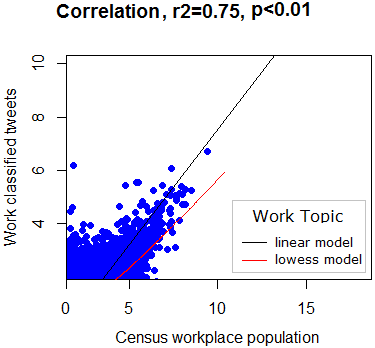Detailed knowledge regarding the whereabouts of people and their social activities in urban areas with high spatial and temporal resolution is still widely unexplored. Thus, the spatiotemporal analysis of Location Based Social Networks (LBSN) has great potential regarding the ability to sense spatial processes and to gain knowledge about urban dynamics, especially with respect to collective human mobility behavior. The objective of a recently published paper in the international journal Computers, Environment and Urban Systems (CEUS) (available online) is to explore the semantic association between georeferenced tweets and their respective spatiotemporal whereabouts. We apply a semantic topic model classification and spatial autocorrelation analysis to detect tweets indicating specific human social activities. We correlated observed tweet patterns with official census data for the case study of London in order to underline the significance and reliability of Twitter data.The visualizationn below shows the observed work activity cluster pattern from tweets and their association with Census populations.
Our empirical results of semantic and spatiotemporal clustered tweets show an overall strong positive correlation in comparison with workplace population census data (see correlation plot), being a good indicator and representative proxy for analyzing workplace-based activities. The outcomes of this study may be considered in future research work regarding the inference and trustworthiness of human mobility patterns from crowdsourced data. Location inference of residential and workplace areas are a key factor of the given transportation demand. LBSN can help to better understand these processes and explore the impact of urban spatial structures on travel demand and human mobility as a future research direction.
Steiger, E. Westerholt, R., Resch, B. and Zipf, A. (2015): Twitter as an indicator for whereabouts of people? Correlating Twitter with UK census data. Computers, Environment and Urban Systems (CEUS). Elsevier. Volume 54, November 2015, Pages 255–265 .doi:10.1016/j.compenvurbsys.2015.09.007





